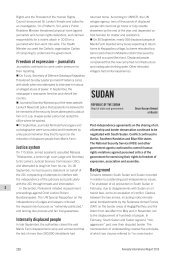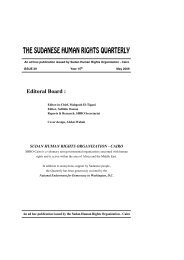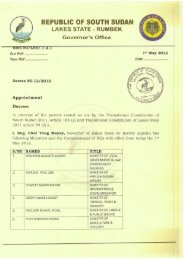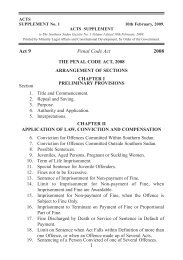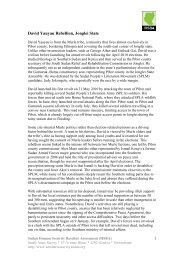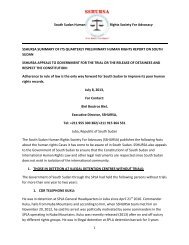The Distribution of Iranian Ammunition in Africa - Conflict Armament ...
The Distribution of Iranian Ammunition in Africa - Conflict Armament ...
The Distribution of Iranian Ammunition in Africa - Conflict Armament ...
You also want an ePaper? Increase the reach of your titles
YUMPU automatically turns print PDFs into web optimized ePapers that Google loves.
CASE STUDIESImage 137.62 x 39 mmammunition recoveredfrom Taliban forces<strong>in</strong> Nawa-I-BarakzayiDistrict, HelmandProv<strong>in</strong>ce, Afghanistan,documented <strong>in</strong>January 2010Notes: <strong>The</strong> cartridgeillustrated is one <strong>of</strong> a numberdocumented dur<strong>in</strong>g the NewYork Times <strong>in</strong>vestigationthat conform to the physicalcharacteristics <strong>of</strong> ammunitionpositively identified as <strong>Iranian</strong><strong>in</strong> orig<strong>in</strong> and documented <strong>in</strong>this report.© C. J. Chivers/New York Times,2010CôTE D’IVOIRE, 2009–12Evidence compiled by <strong>Conflict</strong> <strong>Armament</strong> Researchfrom a range <strong>of</strong> <strong>in</strong>vestigations <strong>in</strong>dicates at leasttwo, unconnected supplies <strong>of</strong> <strong>Iranian</strong> ammunitionto Côte d’Ivoire. <strong>The</strong> first occurred between 2002and 2009 and <strong>in</strong>volved transfers <strong>of</strong> <strong>Iranian</strong> 7.62 x 39mm ammunition to former rebel forces operat<strong>in</strong>g<strong>in</strong> northern Côte d’Ivoire. <strong>The</strong> second case suggeststhat former government forces acquired quantities<strong>of</strong> <strong>Iranian</strong> 7.62 x 54R mm ammunition after 2000,but plausibly s<strong>in</strong>ce a November 2004 UN armsembargo on Côte d’Ivoire.<strong>Iranian</strong> ammunition transfers tonorthern Côte d’IvoireIn October 2009 <strong>The</strong> UN Group <strong>of</strong> Experts onCôte d’Ivoire 37 reported extensive transfers <strong>of</strong>ammunition from the territory <strong>of</strong> Burk<strong>in</strong>a Fasoto rebel forces <strong>in</strong> the north <strong>of</strong> the country. <strong>The</strong>setransfers violated the UN Security Council armsembargo on Côte d’Ivoire imposed by Resolution1572 (2004).<strong>The</strong> transfers consisted <strong>of</strong> large numbers <strong>of</strong>cartridges—then estimated to be <strong>in</strong> excess <strong>of</strong> 0.5million rounds—a substantial proportion <strong>of</strong> whichthe Group <strong>of</strong> Experts was unable to identify. 38<strong>Conflict</strong> <strong>Armament</strong> Research has s<strong>in</strong>ce obta<strong>in</strong>edsamples <strong>of</strong> the unidentified ammunition andconfirmed that it is <strong>Iranian</strong> <strong>in</strong> orig<strong>in</strong> (see Image14). <strong>The</strong> cartridges are identical <strong>in</strong> construction,mark<strong>in</strong>gs and date <strong>of</strong> manufacture to numerousexamples identified <strong>in</strong> East <strong>Africa</strong> (see the casespresented above). 39<strong>The</strong> Group <strong>of</strong> Experts found no examples <strong>of</strong>the <strong>Iranian</strong> ammunition <strong>in</strong> its orig<strong>in</strong>al, factorypackag<strong>in</strong>g. Instead, it noted that the ammunitionhad been repacked <strong>in</strong>to hessian bags (see Image15). <strong>The</strong> Group <strong>of</strong> Experts concluded that theremoval <strong>of</strong> ammunition from its packag<strong>in</strong>g<strong>in</strong>creased the risks <strong>of</strong> damage from environmentalexposure and handl<strong>in</strong>g, and served no militarypurpose beyond concealment. 40<strong>Conflict</strong> <strong>Armament</strong> Research’s f<strong>in</strong>d<strong>in</strong>gs supportthis conclusion. First, many <strong>of</strong> the hessian bagsconta<strong>in</strong>ed only one type <strong>of</strong> identically marked<strong>Iranian</strong> ammunition. This suggests the unpack<strong>in</strong>g <strong>of</strong>homogeneous ammunition straight from its orig<strong>in</strong>alfactory packag<strong>in</strong>g. Second—and support<strong>in</strong>g thisargument—some <strong>of</strong> the cartridges had been packed<strong>in</strong>to small black plastic bags, each conta<strong>in</strong><strong>in</strong>gexactly 20 rounds <strong>of</strong> ammunition. 4128<strong>Conflict</strong> <strong>Armament</strong> Research<strong>The</strong> <strong>Distribution</strong> <strong>of</strong> <strong>Iranian</strong> <strong>Ammunition</strong> <strong>in</strong> <strong>Africa</strong>: Evidence from a N<strong>in</strong>e-country Investigation



